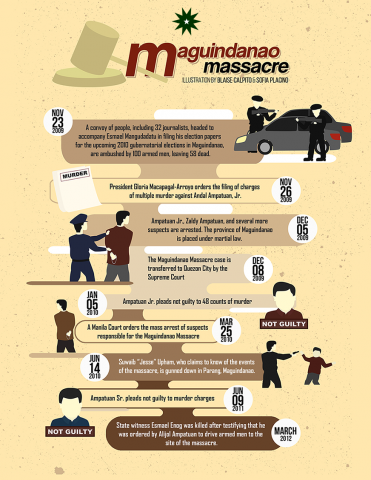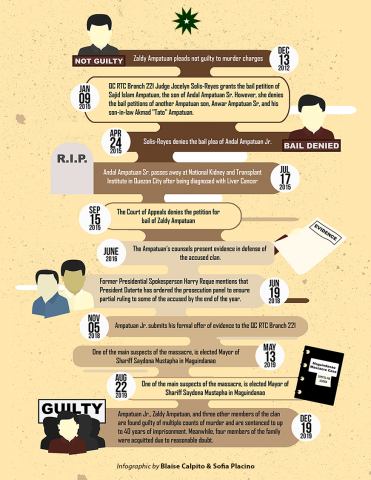It has been 10 years since the Maguindanao Massacre—one of the bloodiest electoral killings in Philippine history. On November 23, 2009, 57 bodies were found buried en masse after more than 100 armed men stopped a convoy carrying relatives and supporters of then Buluan Vice Mayor Esmael Mangudadatu, along with media personnel. The convoy was on its way to file Mangudadatu’s certificate of candidacy at the Commission on Elections office in Shariff Aguak, to challenge Andal Ampatuan Jr., son of then Maguindanao Governor Andal Ampatuan Sr., for the gubernatorial seat.
Mangudadatu, who had been receiving death threats since he expressed an interest in running for office, sent his pregnant wife and other relatives, believing that they would not be harmed because they were women. He also invited journalists, believing that media presence would deter an attack.
But the effort proved futile. Before Mangudadatu’s group could make it to Shariff Aguak, they were brought to Brgy. Salman, where Ampatuan’s men left no survivors. The killers then tried to bury the corpses but instead fled the scene when an army helicopter circled overhead.
Several others who had nothing to do with the convoy, save for being on the same road lane, were killed.
In a single blow, 32 journalists were killed; the international watchdog Committee to Protect Journalists (CPJ) recognizes this incident as the deadliest event for journalists in history.
Lamentations of justice
The horrifying news quickly reverberated across the country. Then-President Gloria Macapagal Arroyo declared a state of emergency and imposed martial law in Maguindanao to maintain order on November 24. Soon enough, news emerged on November 25 that members of the Ampatuan family were behind the massacre. A series of raids on properties owned by the clan uncovered large caches of military equipment, including army uniforms and heavy weapons.
The principal accused, brothers Andal Jr. and Zaldy Ampatuan, along with 200 others, were charged for the killings. Late Sen. Joker Arroyo remarked that the trial could take 200 years to complete because of the sheer number of people involved. Then prosecution lawyer Harry Roque gave a smaller estimate, pegging it at 100 years. Human rights lawyer Rene Saguisag disagreed, though he predicted that the trial would still last for years, and appeals “many more years”.
Difficulties plagued the trial from the very beginning. The original judge appointed to preside over the trial, Luisito Cortez, inhibited himself, fearing reprisal against him and his family. The case instead fell to Quezon City Regional Trial Court Judge Jocelyn Solis-Reyes.
Witnesses were continually harassed and murdered. Suwaib Upham, a former Ampatuan mercenary, was shot in Maguindanao in June 2010. Esmail Amil Enog, who served as the driver for the Ampatuan family, was killed in 2012, while former Ampatuan men Dennis Sakal and Sukarno Butch Sadugal were ambushed in 2014, leaving Sakal dead and Sadugal injured.
Not all defendants would survive to see the ruling. Andal Ampatuan Sr., the patriarch and the alleged mastermind of the massacre, died in 2015 while seven other accused died from various causes as the trial dragged on.
The landmark case has spanned over a decade, until it finally closed on December 19, 2019, when Solis-Reyes ruled that the Ampatuan brothers, along with 43 other accused, were guilty beyond reasonable doubt for their involvement in the massacre.
The judge declared that prosecutors have proven the defendant’s guilt, as they showed that the killing was planned days ahead. Both Ampatuan brothers, along with 28 others, are set to face life imprisonment without parole, or up to 40 years of imprisonment for each of the 57 counts of murder that they were tried for. Meanwhile, 15 individuals were sentenced to six to 10 years of imprisonment for being accessories to murder, whereas Sajid Islam Ampatuan and 54 others have been acquitted.
The Ampatuans have sought a reversal of the Maguindanao Massacre conviction, directly filing their pleas to the Court of Appeals. Families of victims, on the other hand, have filed a motion for partial reconsideration or a notice of appeal. Even with justice served, 80 of the accused still remain at large.
Hammer blows to press freedom
Ten years after the harrowing Ampatuan Massacre, it seems as though the threats to press freedom in the Philippines have only multiplied.
Since 2008, the Philippines has consistently ranked among the worst countries in the Global Impunity Index. The annual report, which is produced by the Committee to Protect Journalists, identifies countries where journalists have been killed and their cases are left unresolved. In 2019, the Philippines placed fifth behind war-torn countries like Somalia, Syria, Iraq, and South Sudan. Though the country is not formally engaged in any war, Filipino journalists are sometimes caught in the crossfire of political conflicts or targeted due to their personal advocacies.
Apart from outright killings, other threats to press freedom have also been made. While visiting earthquake victims in Cotabato late last year, President Rodrigo Duterte solidified his position against the renewal of ABS-CBN’s broadcast franchise. Congress has yet to deliberate on the matter, though the President’s allies claim that they will be impartial and unbiased despite Duterte’s stance.
The Philippine Army also faces allegations of red-tagging journalists like Kristin Lim and Brandon Lee. Lim, who previously managed Radyo Lumad, was harassed by soldiers who wanted to take her in for questioning despite not having a warrant. On the other hand, Lee was a Chinese-American journalist who covered environmental issues in Northern Luzon. He was ambushed en route to his daughter’s school and sustained multiple gunshot wounds that left him in critical condition.
Since the Ampatuan massacre, 52 more media workers have been killed in the country, bringing the total death toll of murdered media practitioners since the return of democracy to the Philippines to 191. In light of these incidents, journalists everywhere are reminded that the Maguindanao Massacre verdict is only the first of many steps that must be taken as the fight for press freedom continues.


